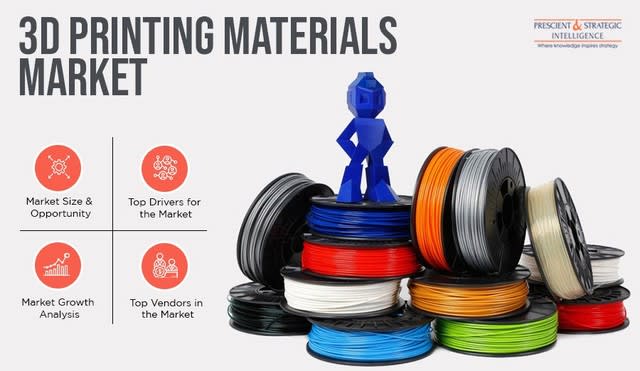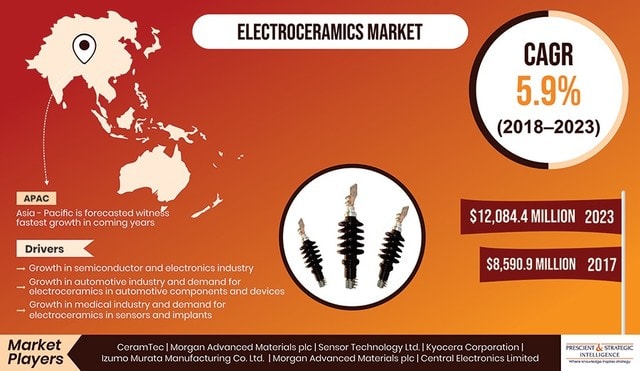As a result of the increasing use of 3D printing in the manufacturing sector, rising demand for automobiles, and the presence of a prosperous aerospace industry, the global 3D printing materials market is expected to reach $1,365.6 million by 2023, from its recorded value of $558.4 million in 2017, registering a CAGR of 16.7% during the forecast period (2018–2023). This high demand for 3D printing materials is primarily due to the rising adoption of additive manufacturing as well as the increasing need for mass customization.
The key factors that are driving the advance of the 3D printing materials market are the increasing popularity of the concept in additive manufacturing and rapidly expanding automobile sector, especially in emerging economies, such as India and China. Additive manufacturing refers to a manufacturing process which uses computer-aided designing (CAD) software to add material, layer by layer, in precise shapes, to create an object. 3D printing, owing to its property of generating almost negligible leftover material, has revolutionized additive manufacturing.
Get a sample copy of the report: http://bit.ly/2QiJlIR

The recent years have witnessed a large-scale integration of additive manufacturing by various companies, in order to yield better results. Currently, the majority of companies are using 3D printing for prototyping. However, in industries such as aerospace and defense and medical and dental, it is being widely used in the complete production process, thereby helping the market prosper. According to a report by Harvard Business Review, the U.S. hearing aid industry has completely incorporated additive manufacturing into its manufacturing process, in 500 days.
On the basis of type, the 3D printing materials market has been divided into ceramics, metals, plastics, and others, wherein the others category includes sand, waxes, marble, wood and stone, and edible materials. Out of these, the plastics category had the largest sales volume share, of over 40.0%, in 2017. The major factor that contributed toward its huge market share was the wide preference for plastics in the process, due to their lower cost and easier melting process, which make forming the final product quick.
Depending on form, the 3D printing materials market is categorized into filament, powder, and liquid. Amongst these, the filament category had the largest market share in 2017, of over 50.0%, in terms of sales volume. Due to their superior characteristics, such as decreased shrinkage, improved layer adhesion, high density, and warp resistance, polylactic acid (PLA) and acrylonitrile butadiene styrene (ABS) are the most commonly used plastic filaments in 3D printing.
The biggest trend in the 3D printing materials market is the incorporation of this production technique in the education sector. In recent times, various schools have adopted 3D printing technologies in their curriculum, in a bid to increase students’ creativity. The technology is also playing a huge role in improving the quality of higher education, especially in science, technology, engineering, and mathematics (STEM), by helping students understand complex mathematical models better.
Thus, due to the increasing use of 3D printing in the manufacturing sector and rising incorporation of the technology in additive manufacturing, the market is set to witness considerable growth in the coming years.
The key factors that are driving the advance of the 3D printing materials market are the increasing popularity of the concept in additive manufacturing and rapidly expanding automobile sector, especially in emerging economies, such as India and China. Additive manufacturing refers to a manufacturing process which uses computer-aided designing (CAD) software to add material, layer by layer, in precise shapes, to create an object. 3D printing, owing to its property of generating almost negligible leftover material, has revolutionized additive manufacturing.
Get a sample copy of the report: http://bit.ly/2QiJlIR

The recent years have witnessed a large-scale integration of additive manufacturing by various companies, in order to yield better results. Currently, the majority of companies are using 3D printing for prototyping. However, in industries such as aerospace and defense and medical and dental, it is being widely used in the complete production process, thereby helping the market prosper. According to a report by Harvard Business Review, the U.S. hearing aid industry has completely incorporated additive manufacturing into its manufacturing process, in 500 days.
On the basis of type, the 3D printing materials market has been divided into ceramics, metals, plastics, and others, wherein the others category includes sand, waxes, marble, wood and stone, and edible materials. Out of these, the plastics category had the largest sales volume share, of over 40.0%, in 2017. The major factor that contributed toward its huge market share was the wide preference for plastics in the process, due to their lower cost and easier melting process, which make forming the final product quick.
Depending on form, the 3D printing materials market is categorized into filament, powder, and liquid. Amongst these, the filament category had the largest market share in 2017, of over 50.0%, in terms of sales volume. Due to their superior characteristics, such as decreased shrinkage, improved layer adhesion, high density, and warp resistance, polylactic acid (PLA) and acrylonitrile butadiene styrene (ABS) are the most commonly used plastic filaments in 3D printing.
The biggest trend in the 3D printing materials market is the incorporation of this production technique in the education sector. In recent times, various schools have adopted 3D printing technologies in their curriculum, in a bid to increase students’ creativity. The technology is also playing a huge role in improving the quality of higher education, especially in science, technology, engineering, and mathematics (STEM), by helping students understand complex mathematical models better.
Thus, due to the increasing use of 3D printing in the manufacturing sector and rising incorporation of the technology in additive manufacturing, the market is set to witness considerable growth in the coming years.













